Influence of the Emulsifier System on Breakup and Coalescence of Oil Droplets during Atomization of Oil-In-Water Emulsions
Abstract
1. Introduction
2. Materials and Methods
2.1. Materials
2.2. Emulsion Preparation
2.3. Atomization of Emulsions
2.4. Single Droplet Experiments
2.4.1. Interfacial Tension Measurements
2.4.2. Measurement of Coalescence Time
3. Results
3.1. Atomization of Emulsions
3.2. Interfacial Tension as Influenced by LMWE
3.3. Coalescence Times as Influenced by LMWE
4. Discussion
5. Conclusions
Author Contributions
Funding
Acknowledgments
Conflicts of Interest
Appendix A

References
- Chen, J.; Dickinson, E. Effect of monoglycerides and diglycerol-esters on viscoelasticity of heat-set whey protein emulsion gels. Int. J. Food Sci. Technol. 1999, 34, 493–501. [Google Scholar] [CrossRef]
- Bos, M.A.; van Vliet, T. Interfacial rheological properties of adsorbed protein layers and surfactants: A review. Adv. Colloid Interface Sci. 2001, 91, 437–471. [Google Scholar] [CrossRef]
- Drapala, K.P.; Auty, M.A.E.; Mulvihill, D.M.; O’Mahony, J.A. Influence of emulsifier type on the spray-drying properties of model infant formula emulsions. Food Hydrocoll. 2017, 69, 56–66. [Google Scholar] [CrossRef]
- Oosting, A.; van Vlies, N.; Kegler, D.; Schipper, L.; Abrahamse-Berkeveld, M.; Ringler, S.; Verkade, H.J.; van der Beek, E.M. Effect of dietary lipid structure in early postnatal life on mouse adipose tissue development and function in adulthood. Br. J. Nutr. 2014, 111, 215–226. [Google Scholar] [CrossRef]
- McClements, D.J.; Li, Y. Structured emulsion-based delivery systems: Controlling the digestion and release of lipophilic food components. Adv. Colloid Interface Sci. 2010, 159, 213–228. [Google Scholar] [CrossRef]
- Taboada, M.L.; Karbstein, H.P.; Gaukel, V. Spray drying of oil-in-water emulsions: Oil droplet breakup during the atomization by pressure-swirl atomizers. In Proceedings of the 29th European Conference on Liquid Atomization and Spray Systems, Paris, France, 2–4 September 2019. [Google Scholar]
- Kleinhans, A.; Hornfischer, B.; Gaukel, V.; Schuchmann, H.P. Influence of viscosity ratio and initial oil drop size on the oil drop breakup during effervescent atomization. Chem. Eng. Process.-Process Intensif. 2016, 109, 149–157. [Google Scholar] [CrossRef]
- Schröder, J.; Kleinhans, A.; Serfert, Y.; Drusch, S.; Schuchmann, H.P.; Gaukel, V. Viscosity ratio: A key factor for control of oil drop size distribution in effervescent atomization of oil-in-water emulsions. J. Food Eng. 2012, 111, 265–271. [Google Scholar] [CrossRef]
- Munoz-Ibanez, M.; Azagoh, C.; Dubey, B.N.; Dumoulin, E.; Turchiuli, C. Changes in oil-in-water emulsion size distribution during the atomization step in spray-drying encapsulation. J. Food Eng. 2015, 167, 122–132. [Google Scholar] [CrossRef]
- Kleinhans, A.; Stähle, P.; Schröder, J.; Gaukel, V.; Schuchmann, H.P. Impact of oil content on effervescent atomization of oil-in-water emulsions. In Proceedings of the 25th European Conference on Liquid Atomization and Spray Systems, Chania, Greece, 1–4 September 2013. [Google Scholar]
- Karbstein, H.P.; Schubert, H. Developments in the Continuous Mechanical Production of O/W-Macro-Emulsions. Chem. Eng. Process. 1995, 34, 205–211. [Google Scholar] [CrossRef]
- Grace, H.P. Dispersion phenomena in high viscosity immiscible fluid systems and application of static mixers as dispersion devices in such systems. Chem. Eng. Commun. 1982, 14, 225–277. [Google Scholar] [CrossRef]
- Armbruster, H. Untersuchungen zum Kontinuierlichen Emulgierprozess in Kolloidmuehlen Unter Beruecksichtigung Spezifischer Emulgatoreigenschaften und der Stroemungsverhaeltnisse im Dispergierspalt. Ph.D. Thesis, University of Karlsruhe, Karlsruhe, Germany, 1990. [Google Scholar]
- van Aken, G.A. Competitive adsorption of protein and surfactants in highly concentrated emulsions: Effect of coalescence mechanisms. Colloids Surf. A Physicochem. Eng. Asp. 2003, 213, 209–219. [Google Scholar] [CrossRef]
- O’Brien, R.D. Fats and Oils: Formulating and Processing for Applications, 3rd ed.; CRC Press: Boca Raton, FL, USA, 2009. [Google Scholar]
- Drapala, K.P.; Auty, M.A.E.; Mulvihill, D.M.; O’Mahony, J.A. Influence of lecithin on the processing stability of model whey protein hydrolysate-based infant formula emulsions. Int. J. Dairy Technol. 2015, 68, 322–333. [Google Scholar] [CrossRef]
- Chesters, A.K. The modelling of coalescence processes in fluid-liquid dispersions: A review of current understanding. Chem. Eng. Res. Des. 1991, 69, 259–270. [Google Scholar]
- Lam, R.S.H.; Nickerson, M.T. Food proteins: A review on their emulsifying properties using a structure-function approach. Food Chem. 2013, 141, 975–984. [Google Scholar] [CrossRef]
- Nylander, T.; Arnebrant, T.; Bos, M.; Wilde, P. Chapter 5: Protein/Emulsifier Interactions. In Food Emulsifiers and Their Applications, 2nd ed.; Hasenhuettl, G.L., Hartel, R.W., Eds.; Springer: New York, NY, USA, 2008; pp. 89–171. [Google Scholar]
- Dickinson, E.; Yamamoto, Y. Effect of lecithin on the viscoelastic properties of β-lactoglobulin-stabilized emulsion gels. Food Hydrocoll. 1996, 10, 301–307. [Google Scholar] [CrossRef]
- Danviriyakul, S.; McClements, D.J.; Decker, E.; Nawar, W.W.; Chinachoti, P. Physical Stability of Spray-Dried Milk Fat Emulsion as Affected by Emulsifiers and Processing Conditions. J. Food Sci. 2002, 67, 2183–2189. [Google Scholar] [CrossRef]
- Cejudo Fernández, M.; Carrera Sánchez, C.; Rodríguez Niño, M.R.; Rodríguez Patino, J.M. Structural characteristics of adsorbed protein and monoglyceride mixed monolayers at the air–water interface. Food Hydrocoll. 2007, 21, 906–919. [Google Scholar] [CrossRef]
- Chen, J.; Dickinson, E. Viscoelastic Properties of Protein-Stabilized Emulsions: Effect of Protein-Surfactant Interactions. J. Agric. Food Chem. 1998, 46, 91–97. [Google Scholar] [CrossRef]
- Matsumiya, K.; Takahashi, Y.; Nakanishi, K.; Dotsu, N.; Matsumura, Y. Diglycerol esters of fatty acids promote severe coalescence between protein-stabilized oil droplets by emulsifier–protein competitive interactions. Food Hydrocoll. 2014, 42, 397–402. [Google Scholar] [CrossRef]
- Wang, S.; Shi, Y.; Tu, Z.; Zhang, L.; Wang, H.; Tian, M.; Zhang, N. Influence of soy lecithin concentration on the physical properties of whey protein isolate-stabilized emulsion and microcapsule formation. J. Food Eng. 2017, 207, 73–80. [Google Scholar] [CrossRef]
- Bylaite, E.; Nylander, T.; Venskutonis, R.; Jönsson, B. Emulsification of caraway essential oil in water by lecithin and β-lactoglobulin: Emulsion stability and properties of the formed oil–aqueous interface. Colloids Surf. B Biointerfaces 2001, 20, 327–340. [Google Scholar] [CrossRef]
- Won, J.Y.; Krägel, J.; Makievski, A.V.; Javadi, A.; Gochev, G.; Loglio, G.; Pandolfini, P.; Leser, M.E.; Gehin-Delval, C.; Miller, R. Drop and bubble micro manipulator (DBMM)—A unique tool for mimicking processes in foams and emulsions. Colloids Surf. A Physicochem. Eng. Asp. 2014, 441, 807–814. [Google Scholar] [CrossRef]
- Dickinson, E.; Murray, B.S.; Stainsby, G. Coalescence stability of emulsion-sized droplets at a planar oil–water interface and the relationship to protein film surface rheology. J. Chem. Soc. Faraday Trans. 1 1988, 84, 871–883. [Google Scholar] [CrossRef]
- Neumann, S.M.; van der Schaaf, U.S.; Karbstein, H.P. Investigations on the relationship between interfacial and single droplet experiments to describe instability mechanisms in double emulsions. Colloids Surf. A Physicochem. Eng. Asp. 2018, 553, 464–471. [Google Scholar] [CrossRef]
- Barbosa-Cánovas, G.V.; Ortega-Rivas, E.; Juliano, P.; Yan, H. Food Powders: Physical Properties, Processing, and Functionality, 1st ed.; Food Engineering Series; Springer: New York, NY, USA, 2005. [Google Scholar]
- Cheng, J.; Cui, J.; Ma, Y.; Yan, T.; Wang, L.; Li, H.; Li, X. Effects of soy-to-milk protein ratio and sucrose fatty acid ester addition on the stability of ice cream emulsions. Food Hydrocoll. 2016, 60, 425–436. [Google Scholar] [CrossRef]
- Neumann, S.M.; Scherbej, I.; van der Schaaf Ulrike, S.; Karbstein, H.P. Investigations on the influence of osmotic active substances on the structure of water in oil emulsions for the application as inner phase in double emulsions. Colloids Surf. A Physicochem. Eng. Asp. 2018, 538, 56–62. [Google Scholar] [CrossRef]
- Neumann, S.M.; van der Schaaf, U.S.; Schuchmann, H.P. The Diffusion and Coalescence Time Analyzer (DCTA): A novel experimental setup for investigating instability phenomena in double emulsions. Food Struct. 2017, 12, 103–112. [Google Scholar] [CrossRef]
- Politova, N.I.; Tcholakova, S.; Tsibranska, S.; Denkov, N.D.; Muelheims, K. Coalescence stability of water-in-oil drops: Effects of drop size and surfactant concentration. Colloids Surf. A Physicochem. Eng. Asp. 2017, 531, 32–39. [Google Scholar] [CrossRef]
- Basheva, E.S.; Gurkov, T.D.; Ivanov, I.B.; Bantchev, G.B.; Campbell, B.; Borwankar, R.P. Size Dependence of the Stability of Emulsion Drops Pressed against a Large Interface. Langmuir 1999, 15, 6764–6769. [Google Scholar] [CrossRef]
- Lee, J.C.; Hodgson, T.D. Film flow and coalescence-I Basic relations, film shape and criteria for interface mobility. Chem. Eng. Sci. 1968, 23, 1375–1397. [Google Scholar] [CrossRef]
- Ban, T.; Kawaizumi, F.; Nii, S.; Takahashi, K. Study of drop coalescence behavior for liquid–liquid extraction operation. Chem. Eng. Sci. 2000, 55, 5385–5391. [Google Scholar] [CrossRef]
- Kumar, M.K.; Ghosh, P. Coalescence of Air Bubbles in Aqueous Solutions of Ionic Surfactants in Presence of Inorganic Salt. Chem. Eng. Res. Des. 2006, 84, 703–710. [Google Scholar] [CrossRef]
- Kamp, J.; Villwock, J.; Kraume, M. Drop coalescence in technical liquid/liquid applications: A review on experimental techniques and modeling approaches. Rev. Chem. Eng. 2017, 33, 1–47. [Google Scholar] [CrossRef]
- Gillespie, T.; Rideal, E.K. The coalescence of drops at an oil-water interface. Trans. Faraday Soc. 1956, 52, 173–183. [Google Scholar] [CrossRef]
- Pays, K.; Giermanska-Kahn, J.; Pouligny, B.; Bibette, J.; Leal-Calderon, F. Coalescence in Surfactant-Stabilized Double Emulsions. Langmuir 2001, 17, 7758–7769. [Google Scholar] [CrossRef]
- McSweeney, S.L.; Healy, R.; Mulvihill, D.M. Effect of lecithin and monoglycerides on the heat stability of a model infant formula emulsion. Food Hydrocoll. 2008, 22, 888–898. [Google Scholar] [CrossRef]
- Neumann, S.M.; Wittstock, N.; van der Schaaf, U.S.; Karbstein, H.P. Interactions in water in oil in water double emulsions: Systematical investigations on the interfacial properties and emulsion structure of the outer oil in water emulsion. Colloids Surf. A Physicochem. Eng. Asp. 2018, 537, 524–531. [Google Scholar] [CrossRef]
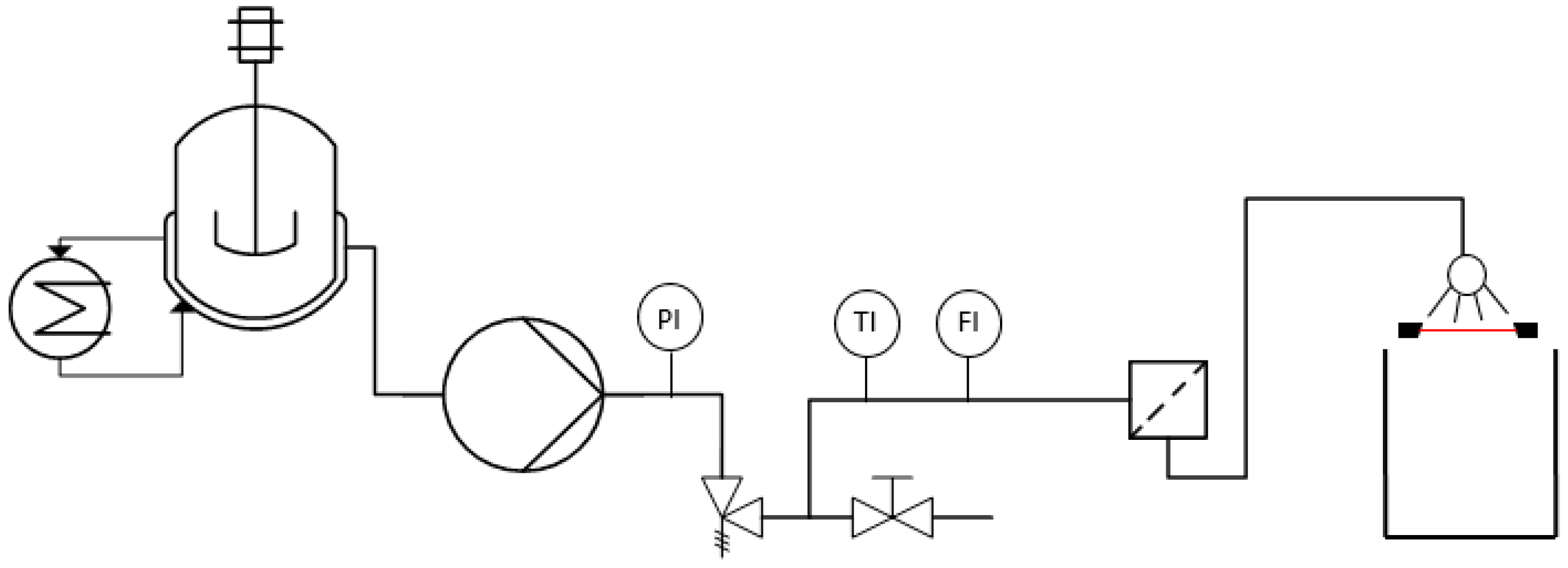
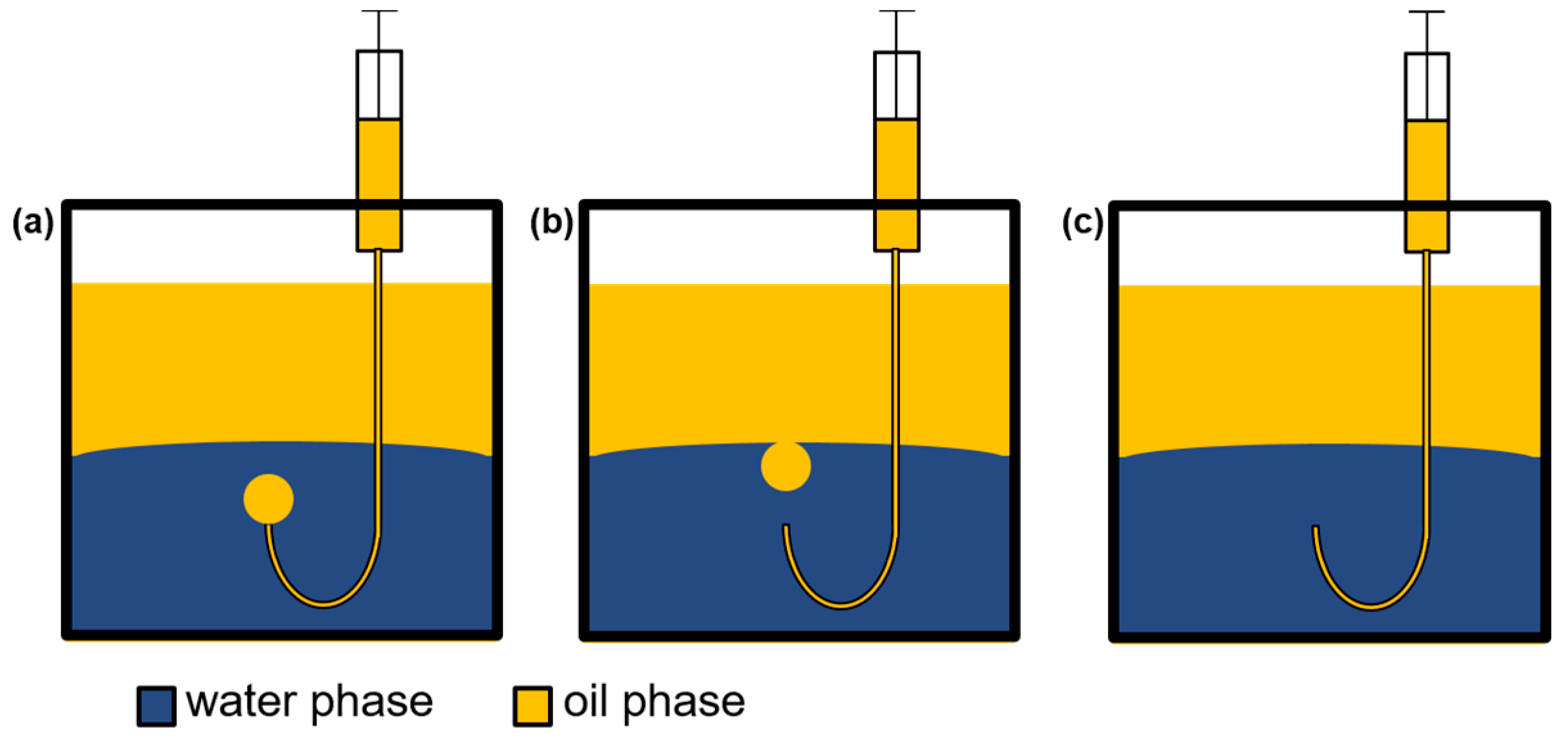
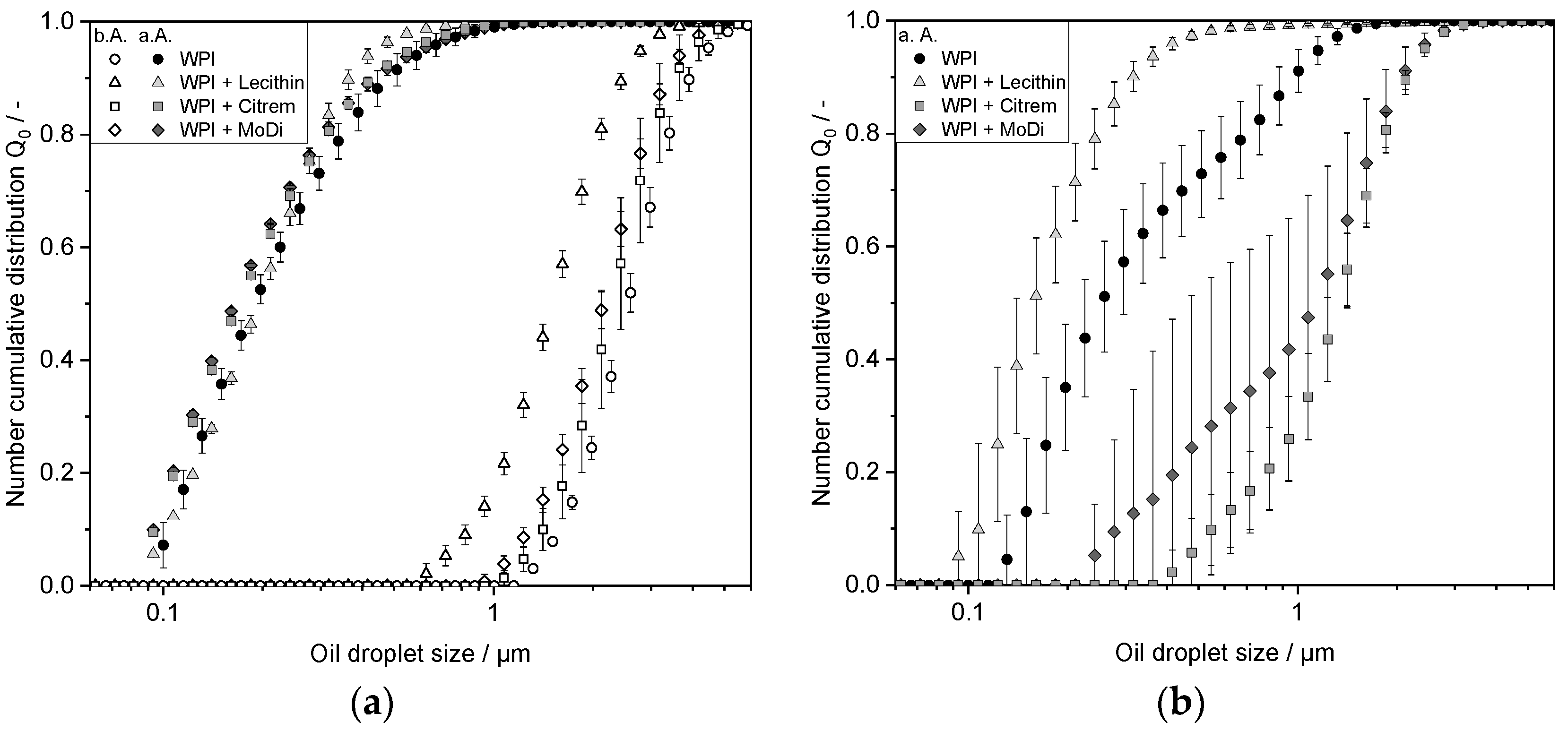

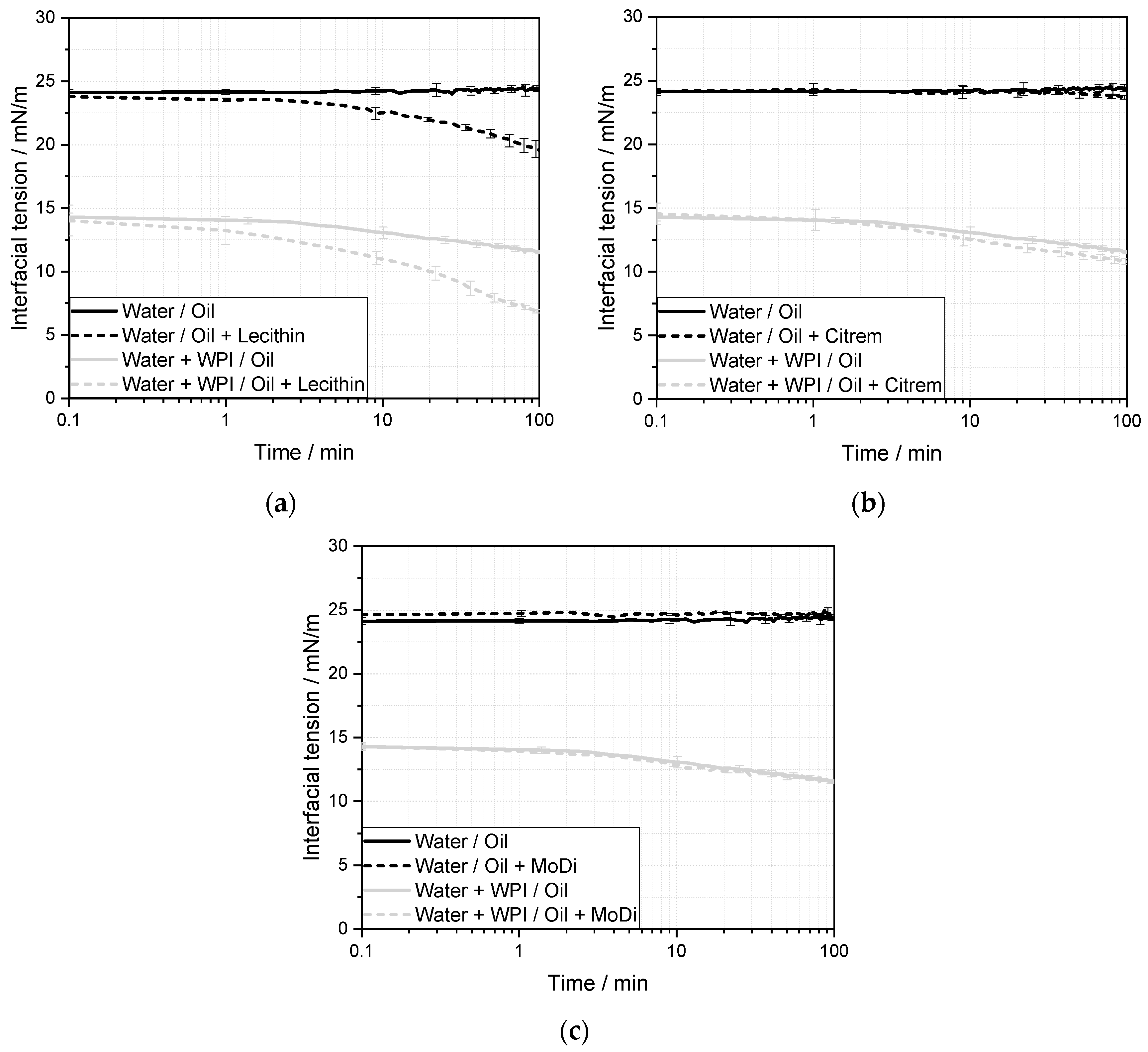
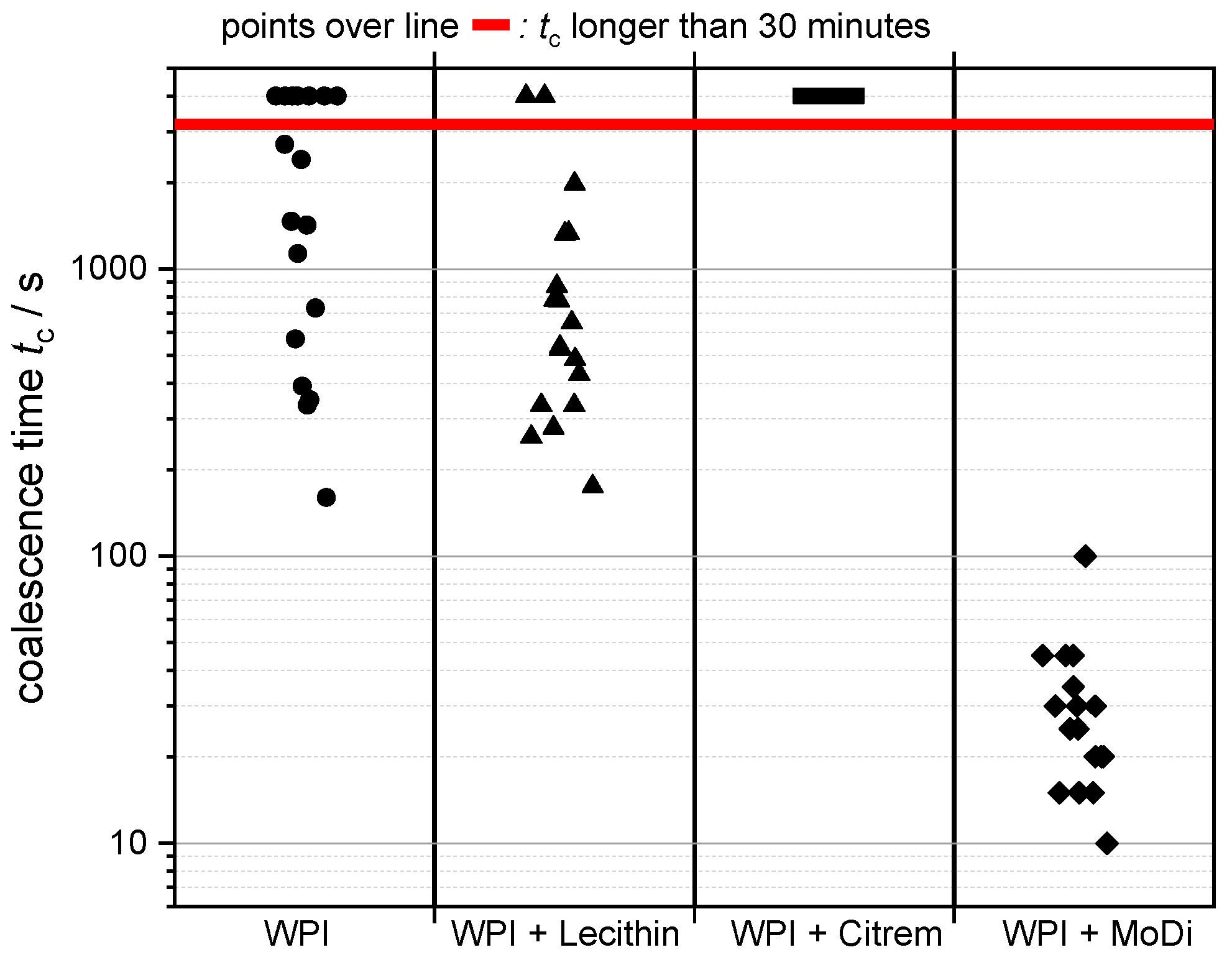
| MCT oil (wt.%) | WPI (wt.%) | LMWE (wt.%) | Maltodextrin (wt.%) | Water (wt.%) |
|---|---|---|---|---|
| 1 | 0.1 | - | 34.3 | 64.6 |
| 0.01 | 64.59 | |||
| 30 | 3 | - | 14.3 | 52.7 |
| 0.3 | 52.4 |
© 2020 by the authors. Licensee MDPI, Basel, Switzerland. This article is an open access article distributed under the terms and conditions of the Creative Commons Attribution (CC BY) license (http://creativecommons.org/licenses/by/4.0/).
Share and Cite
Taboada, M.L.; Leister, N.; Karbstein, H.P.; Gaukel, V. Influence of the Emulsifier System on Breakup and Coalescence of Oil Droplets during Atomization of Oil-In-Water Emulsions. ChemEngineering 2020, 4, 47. https://doi.org/10.3390/chemengineering4030047
Taboada ML, Leister N, Karbstein HP, Gaukel V. Influence of the Emulsifier System on Breakup and Coalescence of Oil Droplets during Atomization of Oil-In-Water Emulsions. ChemEngineering. 2020; 4(3):47. https://doi.org/10.3390/chemengineering4030047
Chicago/Turabian StyleTaboada, Martha L., Nico Leister, Heike P. Karbstein, and Volker Gaukel. 2020. "Influence of the Emulsifier System on Breakup and Coalescence of Oil Droplets during Atomization of Oil-In-Water Emulsions" ChemEngineering 4, no. 3: 47. https://doi.org/10.3390/chemengineering4030047
APA StyleTaboada, M. L., Leister, N., Karbstein, H. P., & Gaukel, V. (2020). Influence of the Emulsifier System on Breakup and Coalescence of Oil Droplets during Atomization of Oil-In-Water Emulsions. ChemEngineering, 4(3), 47. https://doi.org/10.3390/chemengineering4030047







